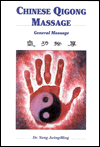Tui Na (pronounced tway-nah) is a style of acupressure massage. It offers all the benefits of traditional western massage, plus the ability to address and alleviate specific health concerns.
A typical Tui Na session uses a variety of strokes along energy channels, as well as gentle shaking, stretching, and movement of the joints. This stimulates and releases the flow of energy, which helps balance your physical and emotional systems.
The resources I’m recommending here are from Dr. Yang Jwing-Ming. His books and videos use the term Qigong Massage rather than Tui Na. There are four categories of Qigong Massage, and Tui Na is one of them.
Dr. Yang has done extensive research on the source documents of Qigong that have recently become available in China. All of his books and tapes are excellent, and I recommend them highly. He is located in Lexington, MA. Here’s a link to his website (www.ymaa.com).
Note that the links below will open in a second browser window.
|
Chinese Qigong Massage, General Massage Although this book will primarily be of interest to individuals who plan to practice Tui Na, the history and theory are very clearly presented, and it includes a chapter on self-massage. The next two items describe the two videotapes designed to accompany the book. |
||
|
Chinese Qigong Massage, Self Massage This video will help you learn simple techniques that you can use anytime for specific conditions. You can also use the tape to practice a daily Tui Na self-massage routine. |
||
|
Chinese Qigong Massage, with a Partner How to give Tui Na to someone else. This video begins with an introduction to the subject, then illustrates a variety of techniques, including how to apply Tui Na massage to the various part of the body. |
||
|
An article on this website about Tui Na. “Western style Tui Na can be thought of as a therapeutic extension of western massage, with an emphasis on restoring and balancing energy.” |
||



